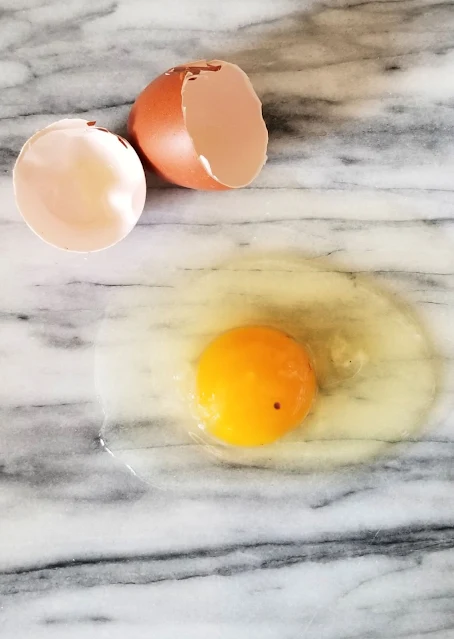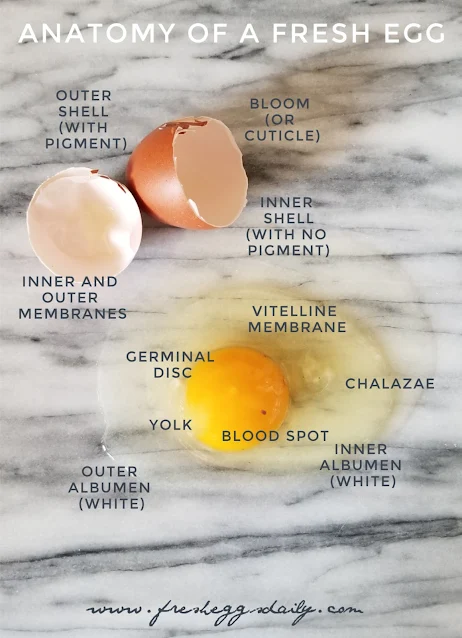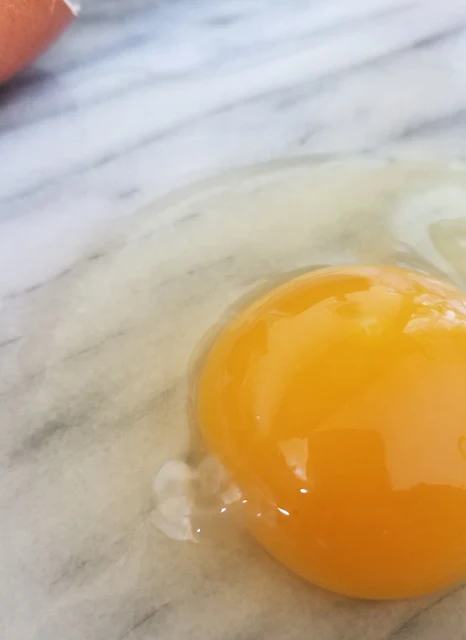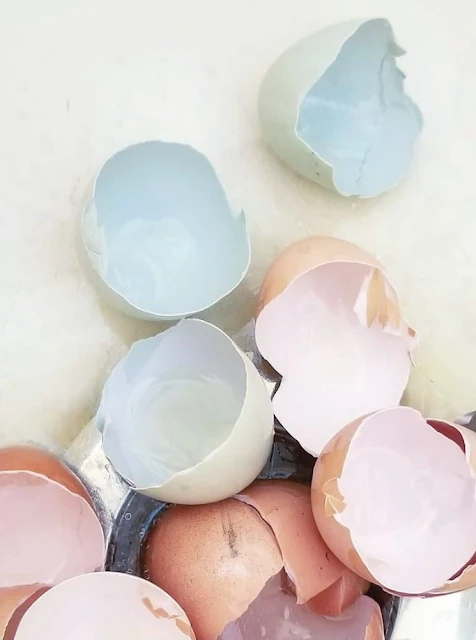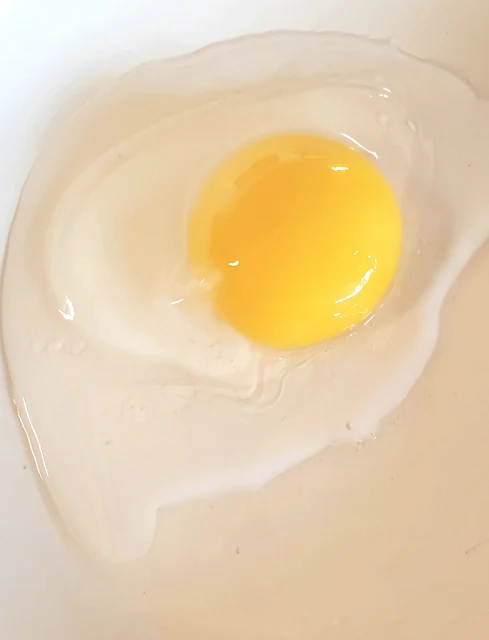Encased inside the hard shell of an egg is the yolk and white, along with everything needed to create new life. Can you name the other parts of an egg?
We all know that an egg is comprised of a shell, and then inside there's the yolk and the white. But an egg is actually oh-so-much-more than that! The anatomy of a fresh egg is pretty fascinating.
- Do you know that the white takes up about two-thirds of the volume of the contents of the eggshell and the yolk takes up the remaining one-third?
-
And the yolk contains about half of the protein in an egg, the majority of nutrients, but also most of the fat.
- Do you know that an egg has every nutrient needed to for life except Vitamin C?
-
Do you know what the thin twisted strands are that you sometimes find in an egg?
- Or why the "white" is sometimes clear and sometimes cloudy?
-
Or how about the blood spot you sometimes find on the yolk?
Anatomy of a Fresh Egg
Egg Shell
The egg is enclosed in a hard layer comprised of mostly calcium carbonate called the shell. The shell also contains magnesium, phosphorus, and trace amounts of copper, iron, manganese, potassium, sodium and zinc.
The eggshell covers the contents of the egg and is the first line of defense against air and bacteria. It makes up about 10% of the total weight of the egg. The average chicken eggshell is .30mm thick and weighs just 1/5th of an ounce.
All egg shells start out white and are created by using the calcium that a hen eats in the form of crushed oyster shell, eggshell or other sources of calcium. Various breeds of chickens then might apply a layer of pigment to the shell to result in a brown, blue or green egg.
The shell is semi-permeable, meaning that oxygen, carbon dioxide, and moisture can pass through its 10,000-20,000 pores. It's this air that enters the egg that a growing embryo will breathe until it hatches.
These pores regulate the movement of air and bacteria into the egg - and carbon dioxide and moisture out of the egg.
Laying hens require adequate levels of calcium, in the form of crushed eggshells or oyster shell, to create strong shells for the eggs they lay. Without enough calcium, they will leach it from their bones, or lay eggs with thin, breakable or soft shells.
Albumen (or Egg White)
An egg white contains protein, as well as niacin, riboflavin, magnesium, potassium and sodium, but not nearly as much nutrition as the yolk. But on the flip side, an egg white only contains about 17 calories and no fat or cholesterol.
The albumen or egg white of a freshly laid egg will be cloudy, not completely clear. This is because it contains carbon dioxide that slowly seeps out as the egg ages, turning the white clear.
A fresh egg white will appear yellow due to the riboflavin it contains, but will turn white when cooked. As the egg ages, the white will lose the yellow coloring as it thins out. The fresher the egg, the thicker and cloudier the albumen.
The albumen actually consists of four parts: the inner thick albumen, the inner thin albumen, and the outer thick albumen and the outer thin albumen. These layers are designed to protect and cushion a chick embryo as it develops.
These layers get more watery as the egg ages and the proteins change, so an older egg will spread out in the pan more than a fresh egg.
Blood Spot
Occasionally you'll find an egg with a tiny red speck on the yolk called a blood spot. This is not an indication of a fertile egg, it's merely a blood vessel on the surface of the yolk that broke during the formation of the egg.
Although it's perfectly edible, most people prefer to remove a blood spot with the tine of a fork or tip of a knife before preparing the egg to eat.
Bloom (or Cuticle)
The bloom or cuticle is a nearly invisible natural coating applied to the eggshell that helps to seal the pores in the shell and keep out air and bacteria.
Washing an egg removes that bloom, allowing the egg to age more quickly and lose its freshness, as well as increase the chance of bacteria entering into the egg.
As the egg ages, the bloom dries and starts to flake off, allowing limited air to get inside to form the air sac that provides air to a developing embryo to breathe.
Chalazae
When you crack a very fresh egg, you might see thin, white ropes trailing from the yolk. These are twisted strands of protein that anchor the yolk in place in the center of the egg white.
They are normally only visible in very fresh eggs.
Like blood spots, they are perfectly edible, but you might want to remove them before eating the egg.
Germinal Disc
A small, almost unnoticeable white dot on the yolk of an egg is called the germinal disc. It's the entrance to a tiny path that leads to the center of the yolk.
And it's this path that the sperm in a fertilized egg will travel to create the embryo and begin to form a baby chick.
Related to the germinal disc is the "bulls eye".
Once the egg is fertilized, several concentric rings form around the dot of the germinal disc, creating a bulls eye, which is the one visible indication of a fertile egg.
Membrane
There are actually two membranes inside an egg that separate the shell from the egg white - an inner membrane and an outer membrane.
Once the egg is laid and begins to cool to room temperature, the membranes begin to separate and air starts to seep in between them, as well as create an air sac at the blunt end of the egg.
Fresh eggs don't hard boil well because until a couple of weeks go by, there's not enough air in between the membranes to allow them to easily separate and for you to peel the shell off.
Pigment
All eggshells start out white. Then, depending on the breed of chicken, pigment is applied to the outside of the shell. That pigment is either brown or blue.
The blue pigment is applied early in the laying process and that color seeps through to the inside of the shell. The brown pigment is applied much later, so the inside of brown eggshells is still white.
Some breeds have both brown and blue pigment, and their eggs turn out green, with blue insides!
Vitelline Membrane
The vitelline membrane is a thin covering that helps keep the yolk contained. It's strongest when the egg is fresh, so fresh egg yolks stand up nice and tall and don't spread out when you crack the egg.
The yolk of a fresh egg is less likely to break because of the vitelline membrane. As the egg ages, the vitelline membrane thins and becomes weaker, making the yolk more likely to break when you crack it into your skillet.
Yolk
The yolk of the egg contains all of the fat and cholesterol, and most of the calories in an egg, but also the majority of the vitamins and nutrients, including vitamins A, B, D, E and K, as well as calcium, folic acid, iron, manganese, phosphorus, protein, selenium, thiamine and zinc.
In fact, an egg contains every nutrient needed for life except Vitamin C. This is because a chicken is able to manufacture Vitamin C in its body through a process called denovo synthesis through with they can turn glucose into the ascorbic acid (Vitamin C).
Usually an egg is laid with only one yolk, but occasionally, two yolks are released into the hen's oviduct too close together and they both are encased in the same shell resulting in a double-yolked egg.
Perfect for scrambling or making an omelet, I would skip using a double-yolked egg for baking because you might throw off your ratios!
Now you know!
The next time you crack open a fresh egg, you'll be able to spot all the various parts that make up the egg.
Pin This!
Further Reading/References:
https://www.exploratorium.edu/cooking/eggs/eggcomposition.html
https://www.fresheggsdaily.blog/2013/07/egg-anatomy-whats-inside-that-eggshell.html
https://www.incredibleegg.org/eggcyclopedia/a/albumen/Biology of Eggs
Join me here
Facebook | Twitter | Instagram | YouTube
©2020 by Fresh Eggs Daily, Inc. All rights reserved



